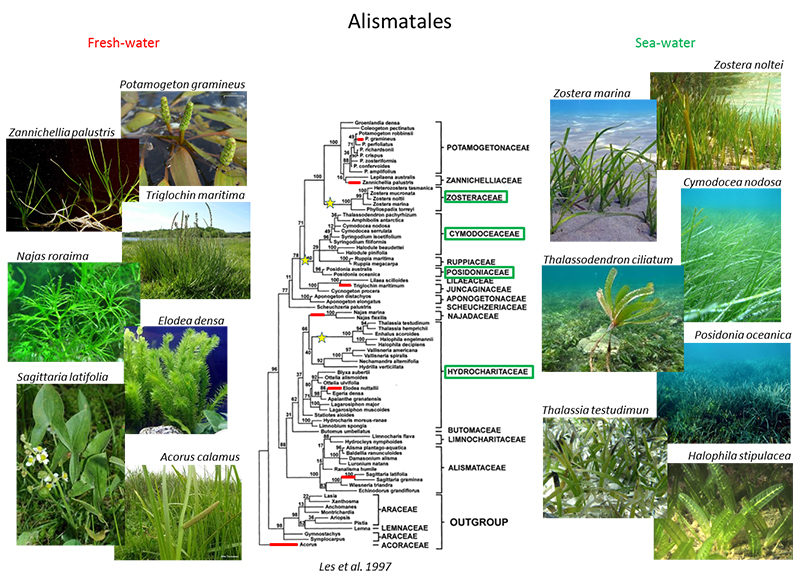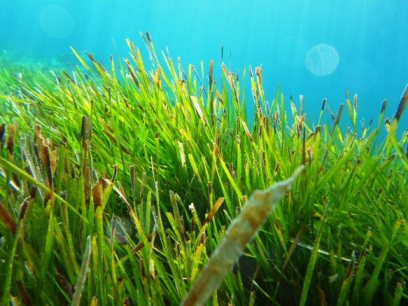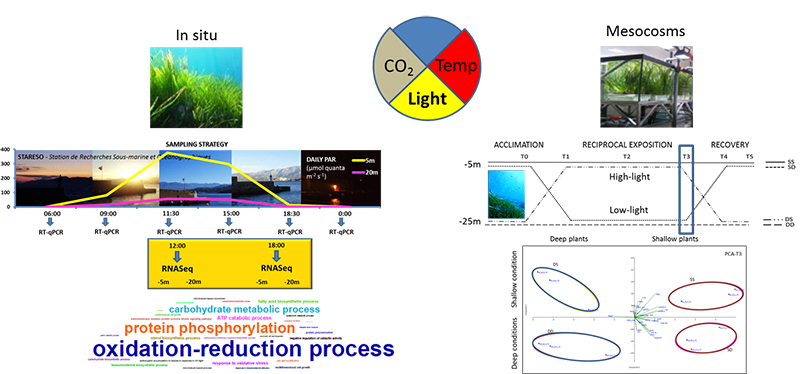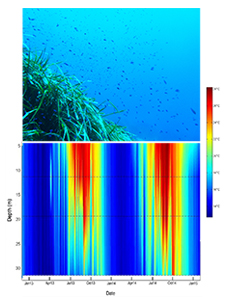During the mid-Cretaceous (145-66 Million years ago), three monocot lineages, belonging to the Alismatales, returned to the sea.
Seagrasses now cover approximately 200,000 km2 of shallow sedimentary shorelines worldwide (except Antarctica).

Their ecosystem services, include nutrient retention, erosion control, a nursery for juvenile fish and invertebrates, and carbon sequestration. These features render them one of the most valuable ecosystems on Earth—surpassing, for example, the economic value of tropical rainforests. As an important sink for anthropogenic carbon, they account for an estimated 15% of carbon fixed in the global ocean. Approximately 10% of the carbon in the deep sea is derived from seagrass leaf litter. The footprint of their evolution is recorded in their genome (the DNA) and the solutions they found (and continue to find) to adapt to their unique marine environment are controlled by the expression of genes and ultimately implemented by proteins and other specialized molecules. Utilizing Ecological Evolutionary Functional Genomic (EEFG) approaches the Procaccini group is studying the adaptive response of seagrasses to key environmental factors—such as temperature, light and CO2 (ocean acidification)—using both natural and controlled laboratory conditions, through an experimental mesocosm system that mimic human-induced changes including climate change. Studies are carried out through integration of transcriptomic (RT-qPCR, RNA-Seq) and physiologic approaches for identifying target mechanisms and processes underlying the adaptive response.
The footprint of their evolution is recorded in their genome (the DNA) and the solutions they found (and continue to find) to adapt to their unique marine environment are controlled by the expression of genes and ultimately implemented by proteins and other specialized molecules. Utilizing Ecological Evolutionary Functional Genomic (EEFG) approaches the Procaccini group is studying the adaptive response of seagrasses to key environmental factors—such as temperature, light and CO2 (ocean acidification)—using both natural and controlled laboratory conditions, through an experimental mesocosm system that mimic human-induced changes including climate change. Studies are carried out through integration of transcriptomic (RT-qPCR, RNA-Seq) and physiologic approaches for identifying target mechanisms and processes underlying the adaptive response.
Light in the sea is spectrally shifted as well as reduced with depth and/or water clarity. A recent field study focused on Posidonia oceanica, iconic Mediterranean seagrass, followed the daily light cycle to assess circadian variation in the expression of a set of target genes related to oxidation-reduction through photosynthesis and carbohydrate metabolic changes. Using Illumina RNA-Seq the first complete transcriptome of the species has been characterized, and the main depth-dependent metabolic pathways, such as oxidation-reduction and carbohydrate metabolic processes have been identified. The differential gene expression in a reciprocal transplant experiment has been analyzed utilizing plants collected from different depths (5 meters to 25 meters) and grown in mesocosms under different light regimes. It has also been found that plants have low adaptive potential and that deep plants actually suffer from high light conditions, with important implications in the selection of donor material for reforestation strategies.

 The Procaccini group is working in the assessment of seagrasses response to abrupt changes in water temperature, simulating heatwaves in controlled conditions.
The Procaccini group is working in the assessment of seagrasses response to abrupt changes in water temperature, simulating heatwaves in controlled conditions.
Coastal ecosystems, in fact, are suffering for the increased frequency and intensity of summer heatwaves, due to global climatic change.
The assessment of differential degrees of response in distinct meadows (through latitudinal and depth gradients), will allow targeted management plans of this important resource.
It was found that population adaptive response (e.g. expression of target genes) depends from the thermal regime experienced in natural conditions.
For the first time it was observed that an increment in temperature of 4°C above the mean summer temperature induced massive flowering










